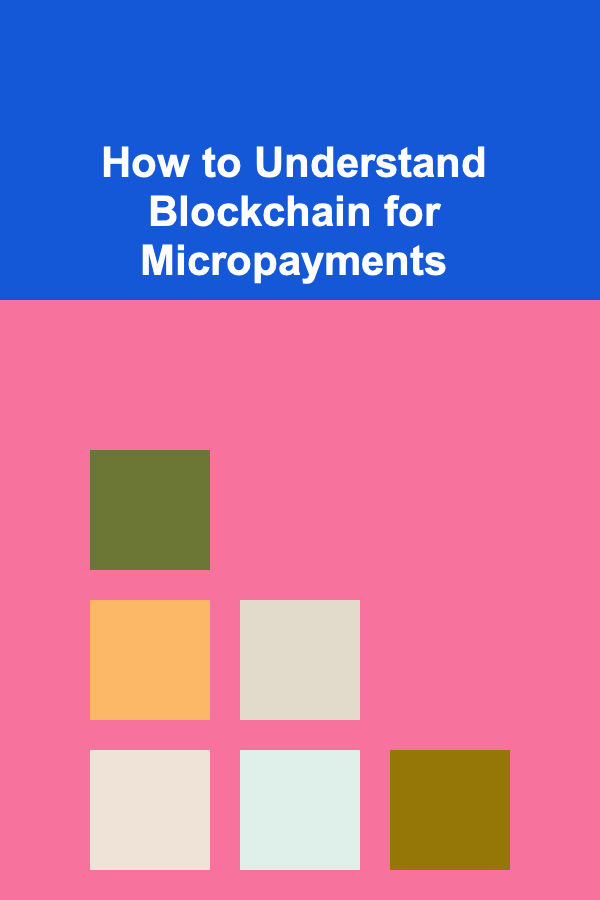
How to Understand Blockchain for Micropayments
ebook include PDF & Audio bundle (Micro Guide)
$12.99$7.99
Limited Time Offer! Order within the next:

Blockchain technology has been around for over a decade now, initially rising to prominence as the foundation of cryptocurrencies like Bitcoin. Its appeal lies in the promise of decentralization, security, transparency, and the potential to transform various industries. While blockchain's impact on industries such as finance, supply chain management, and healthcare has been widely discussed, one of the most promising applications of blockchain is in the realm of micropayments.
Micropayments are typically small transactions---often of less than a dollar or even a cent---that are difficult to process using traditional payment systems due to high fees and inefficiencies. However, blockchain, with its ability to operate outside traditional financial systems, has the potential to revolutionize how these transactions are carried out.
In this article, we will explore the fundamentals of blockchain technology, how it works for micropayments, and the opportunities it presents. We'll also examine some of the challenges and solutions in using blockchain for micropayments and look at some real-world use cases.
What is Blockchain?
Before diving into micropayments, it is essential to understand what blockchain is and how it works.
At its core, blockchain is a decentralized digital ledger that records transactions across many computers in a way that makes it difficult or impossible to alter the transaction history. Each "block" in the chain contains a list of transactions, and every new block is linked to the previous one, forming a chain. This structure ensures that once data is recorded, it cannot be tampered with without altering every subsequent block, which would require the consensus of the majority of participants in the network.
Blockchain's decentralization is its key feature. Unlike traditional centralized systems (such as banks), where a central authority verifies and processes transactions, blockchain uses a distributed network of nodes (computers) that validate and record transactions. This decentralized approach ensures that there is no single point of failure, making the system more secure and resistant to censorship.
What Are Micropayments?
Micropayments are small financial transactions, typically valued at a fraction of a dollar, which are often impractical to process using traditional payment systems due to the high fees associated with such transactions. For example, paying for a small digital item or service, like a single article or song, becomes inefficient when traditional payment methods like credit cards or PayPal charge a fixed fee that is a significant percentage of the total transaction.
Historically, micropayments have struggled to gain traction due to several barriers:
- High Transaction Fees: Traditional payment processors charge a minimum fee per transaction, making small payments unfeasible. For example, a 30-cent transaction fee on a 10-cent purchase is simply too high.
- Slow Transaction Times: Processing small transactions on traditional networks can be slow, especially for cross-border payments.
- Lack of Infrastructure: There has been little infrastructure in place to facilitate micropayments, especially for small digital content purchases, such as articles, apps, or digital assets.
However, with the advent of blockchain, these challenges are being addressed. Blockchain allows for efficient, low-cost, and fast transactions, which makes it an ideal technology for micropayments.
How Blockchain Solves the Micropayment Problem
1. Lower Transaction Fees
One of the primary reasons blockchain is so well-suited to micropayments is its ability to dramatically reduce transaction fees. Traditional payment systems require intermediaries (banks, payment processors, etc.) to handle transactions, each of which charges a fee for their services. These fees often include fixed costs (like a flat fee per transaction) as well as variable costs (such as a percentage of the total amount).
Blockchain, on the other hand, operates without intermediaries. In blockchain-based transactions, the participants (the buyer and the seller) can directly exchange value through the network. The network participants (miners or validators) are compensated with transaction fees, but these fees are usually much lower than traditional payment systems, especially for small transactions.
For example, Bitcoin and Ethereum have introduced layer-two solutions (such as the Lightning Network and Optimistic Rollups) that enable faster, cheaper transactions, making it possible to handle micropayments efficiently. The Lightning Network, for example, allows for the creation of payment channels where users can send a large number of transactions off-chain, only settling the final balance on the main blockchain.
2. Fast Transactions
Blockchain transactions can also be processed much faster than traditional payment methods. Bitcoin transactions, for example, can be confirmed within minutes. Ethereum-based transactions, depending on network congestion, can be processed in seconds to minutes. Additionally, layer-two solutions like the Lightning Network can allow for near-instantaneous transactions, making blockchain an ideal technology for micropayments where speed is important.
With traditional payment systems, such as credit card networks or bank transfers, small payments might take hours or even days to settle, particularly when cross-border transactions are involved. Blockchain's decentralized nature allows for peer-to-peer transactions that are processed almost immediately, removing the delays inherent in traditional banking systems.
3. Increased Accessibility
Blockchain enables micropayments in regions where access to traditional banking systems is limited or unavailable. Many people around the world lack access to banking services, especially in developing countries, making it difficult for them to engage in even small transactions online. Blockchain provides a decentralized solution, allowing anyone with an internet connection to participate in the digital economy, whether they have a bank account or not.
Furthermore, blockchain enables cross-border micropayments with minimal fees, opening up global markets for businesses and consumers alike. Small transactions can be made seamlessly between users in different countries, without the need for expensive international remittance services.
4. Security and Transparency
Blockchain's inherent security features make it well-suited for micropayments. Each transaction on the blockchain is cryptographically secured, making it virtually impossible for third parties to tamper with the transaction history. This level of security ensures that micropayments are safe and that funds cannot be fraudulently intercepted.
Additionally, blockchain provides transparency. Since all transactions are recorded on a public ledger, anyone can verify the authenticity of a transaction. This transparency builds trust between parties, especially in situations where trust might otherwise be a concern.
5. Smart Contracts
Blockchain also enables the use of smart contracts, which are self-executing contracts with the terms of the agreement directly written into code. Smart contracts can facilitate micropayments by automatically executing transactions when certain conditions are met. For instance, a content creator could set up a smart contract that automatically receives micropayments whenever a user accesses a particular article or digital service.
This automation reduces the need for manual intervention, streamlining the process and reducing the risk of errors or disputes. For micropayments, this is particularly beneficial because it removes the friction that can make small payments cumbersome for both the sender and the receiver.
Use Cases for Blockchain-Based Micropayments
1. Digital Content
One of the most promising applications of blockchain for micropayments is in the digital content industry. Whether it's articles, music, videos, or software, digital content creators often face challenges in monetizing their work due to high fees and friction in traditional payment methods.
With blockchain, creators can charge small amounts for access to their content without worrying about the high fees charged by payment processors. Microtransactions can be automated using smart contracts, and users can pay per article, song, or video stream. This system opens up new revenue models for content creators, enabling them to monetize even small portions of their work, like a single article or a short song.
For example, a journalist could charge readers a few cents for access to individual articles instead of requiring them to subscribe to an entire publication.
2. Gaming and Virtual Goods
Blockchain-based micropayments are already making waves in the gaming industry, where players often buy virtual goods, in-game items, or additional content. Traditional payment systems can make these small transactions expensive due to fees, but blockchain allows gamers to purchase virtual assets directly and with lower transaction costs.
Blockchain can also help with the creation of decentralized gaming platforms where players can use tokens to make micropayments for in-game purchases, item trading, and even tipping other players. This type of decentralized model allows for greater flexibility and reduces the reliance on centralized platforms, creating a more player-centric economy.
3. Tipping and Crowdfunding
Blockchain micropayments also have a significant potential in online tipping and crowdfunding. Platforms like Patreon allow creators to receive regular payments from their supporters, but blockchain allows for even smaller, more spontaneous payments. A fan could tip a creator for a single tweet or a short video, and the transaction can be processed instantly and with minimal fees.
This use of blockchain is particularly beneficial for micro-contributions, which might otherwise be impractical through traditional payment systems due to the cost of processing fees.
Challenges in Using Blockchain for Micropayments
Despite the many benefits of using blockchain for micropayments, there are several challenges that need to be addressed:
1. Scalability
While blockchain networks like Bitcoin and Ethereum are growing in popularity, they still face scalability issues. The more transactions a network handles, the slower and more expensive the network becomes. Micropayments require extremely fast and cost-effective transactions, which means blockchain networks must continue to evolve to handle large volumes of small transactions.
Layer-two solutions, such as the Lightning Network for Bitcoin or Rollups for Ethereum, aim to solve these scalability issues by enabling faster and cheaper off-chain transactions that are later settled on the main blockchain.
2. User Experience
The user experience of blockchain-based micropayments is still relatively complicated for non-technical users. Wallets, private keys, and transaction fees can be confusing for someone who is not familiar with cryptocurrency. Improving the usability of blockchain-based payment systems is crucial for mainstream adoption.
3. Regulation
As blockchain technology grows, regulators are beginning to take an interest in its potential impact on the financial sector. Although blockchain promises greater financial inclusion, there is still uncertainty around the regulation of cryptocurrency payments, particularly with respect to anti-money laundering (AML) and know-your-customer (KYC) requirements. These regulatory challenges could slow down the adoption of blockchain-based micropayments.
Conclusion
Blockchain technology has the potential to revolutionize the way micropayments are made by offering low-cost, fast, and secure transactions. By removing intermediaries and providing a decentralized solution, blockchain makes it possible for small transactions to become a viable option for businesses and consumers. Whether in the realm of digital content, gaming, tipping, or crowdfunding, blockchain-based micropayments are paving the way for new business models and economic systems.
While there are still challenges to overcome, particularly in terms of scalability and user experience, the future of blockchain for micropayments looks bright. With continued innovation and the adoption of layer-two solutions, blockchain could become the standard for processing small transactions in the digital economy.

How to Build a Checklist for Reducing Shipping Costs
Read More
How to Integrate Lighting Into Your Home's Seasonal Decor
Read More
How to Interpret the Latest Astronomical Discoveries
Read More
How To Promote Independent Play and Learning
Read More
How to Manage Your Finances as an Entrepreneur
Read More
10 Must-Have First Aid Kit Items for Home
Read MoreOther Products

How to Build a Checklist for Reducing Shipping Costs
Read More
How to Integrate Lighting Into Your Home's Seasonal Decor
Read More
How to Interpret the Latest Astronomical Discoveries
Read More
How To Promote Independent Play and Learning
Read More
How to Manage Your Finances as an Entrepreneur
Read More